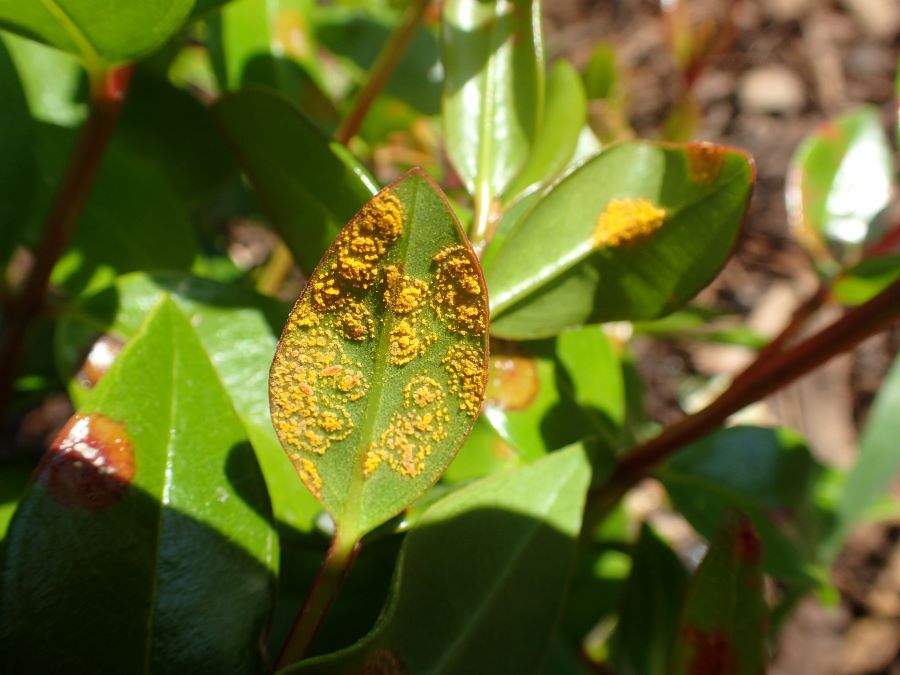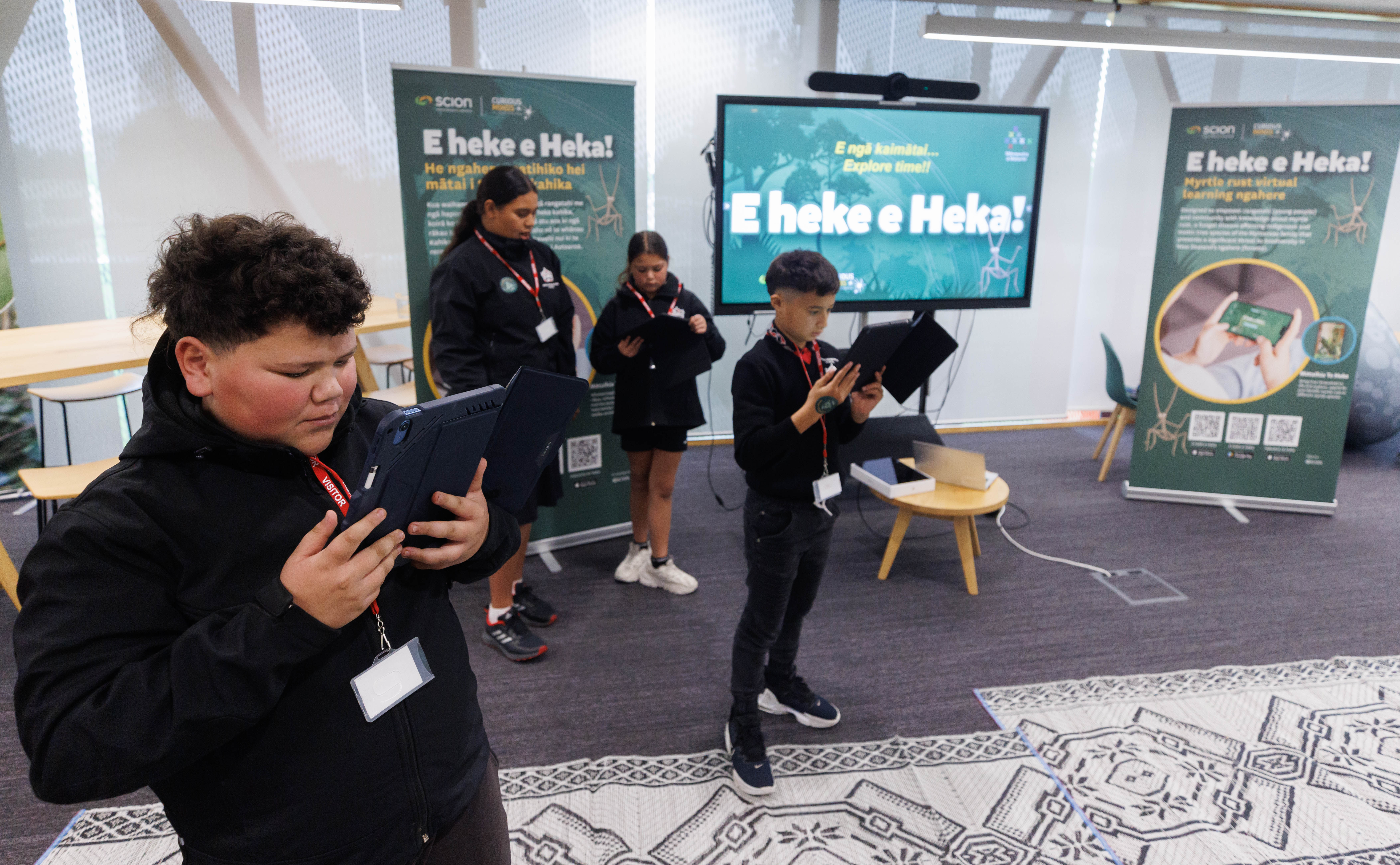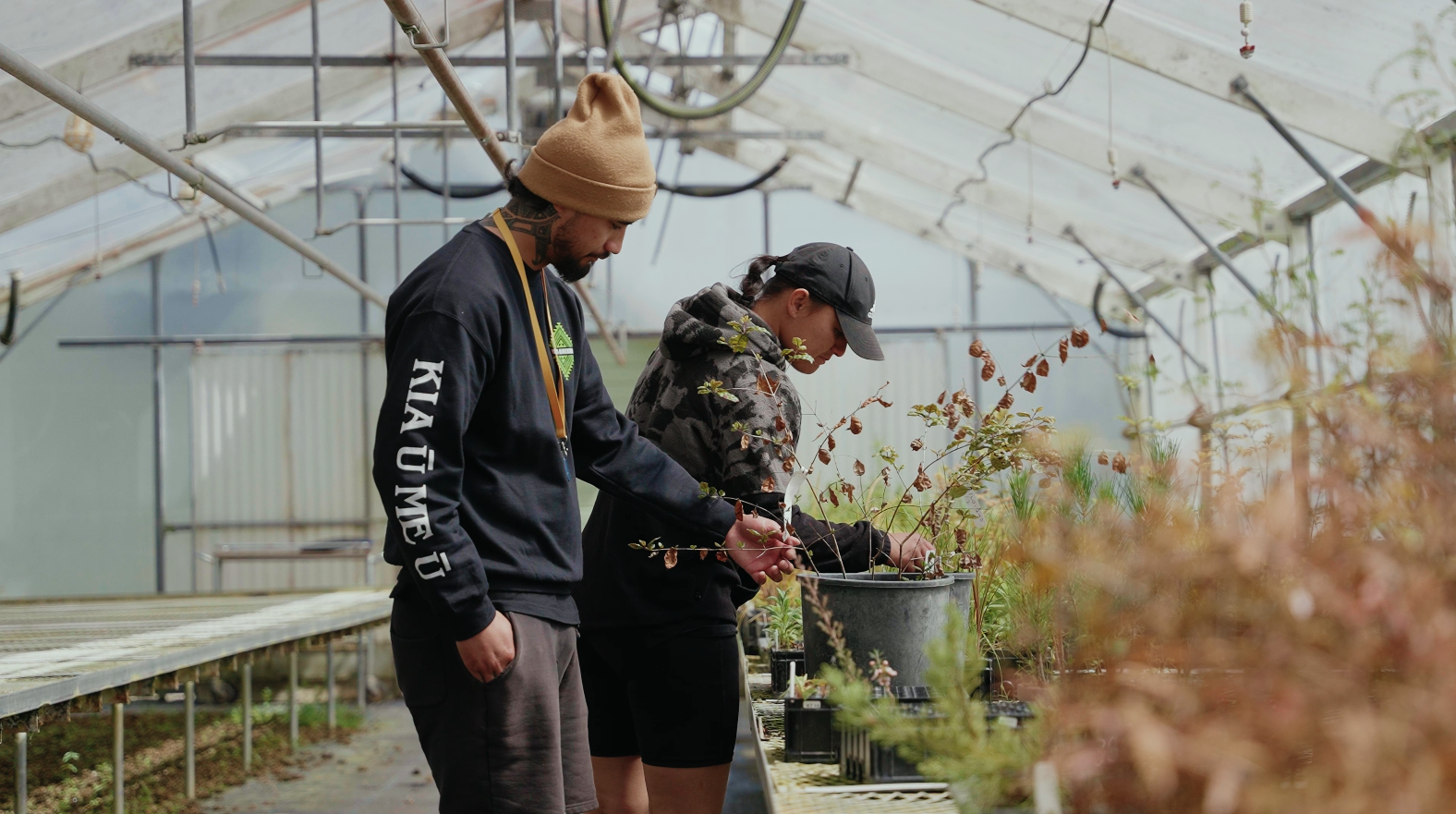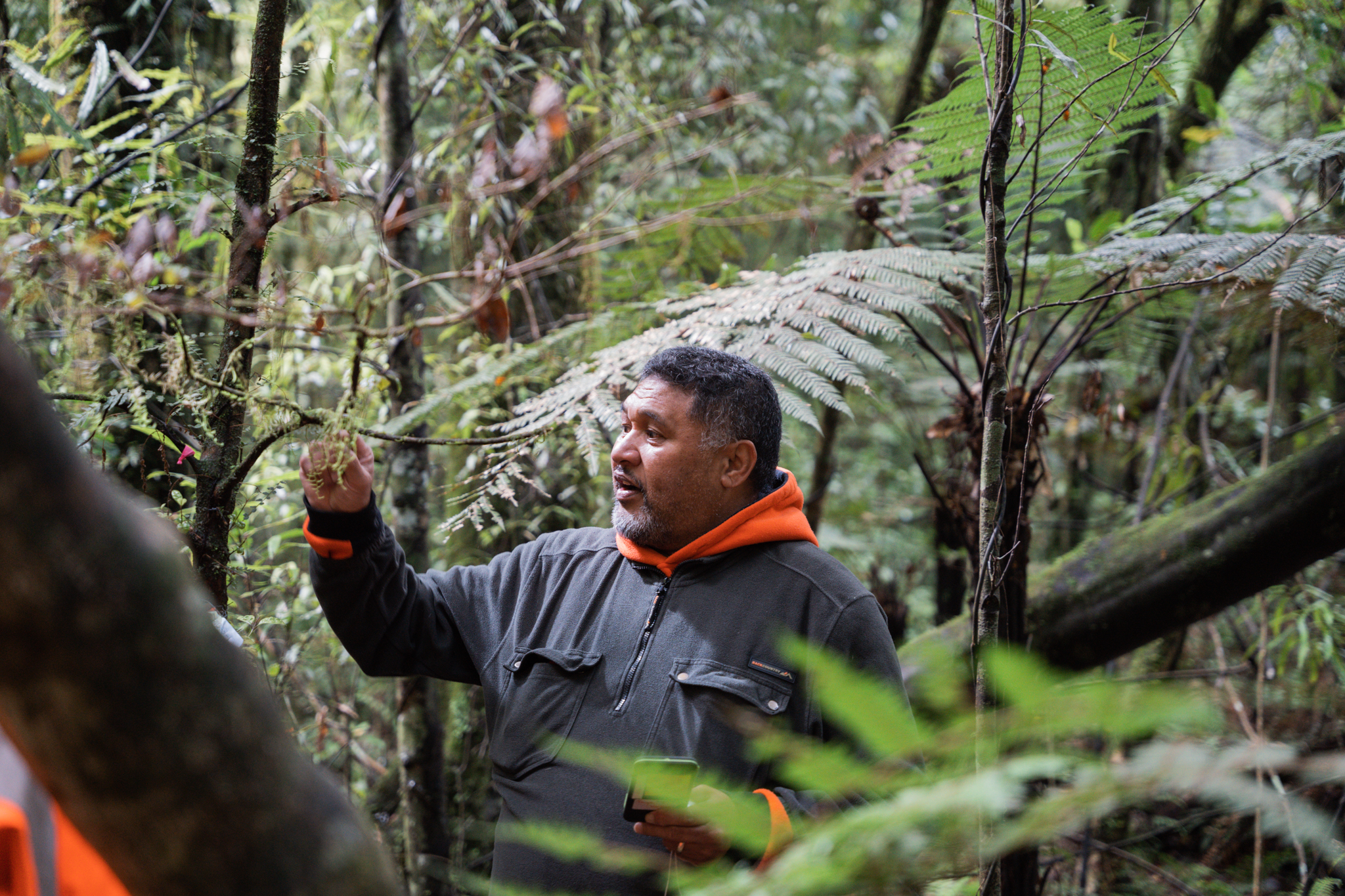Myrtle rust research and education
Since its discovery on mainland New Zealand in 2017, myrtle rust has spread across the country threatening several of our taonga indigenous Myrtaceae species alongside exotics.
Initial attempts to contain the disease have pivoted from containment to long-term management through public awareness and research. Scion plays a critical role in both.
About myrtle rust
Caused by the fungus Austropuccinia psidii, myrtle rust is a serious fungal disease that poses a significant threat to New Zealand’s native flora, specifically members of the myrtle family including taonga species, such as pōhutukawa, mānuka, rātā, and others. It also threatens exotics like feijoa, guava and eucalypts.
Austropuccinia psidii spreads via wind-borne spores. The infection leads to reduced growth, dieback and in severe cases, plant death. Its presence endangers the health of native ecosystems, cultural heritage and biodiversity, and impacts the horticultural industry.

Our work
Scion is collaborating and delivering research to support New Zealand's need to protect our native and exotic myrtle plants and educate the community about the risk.
Te Rātā Whakamaru
In 2022, the Department of Conservation – Te Papa Atawhai funded the ‘Myrtle Rust – Jobs for Resistance/Te Rātā Whakamaru’ project as part of the Jobs for Nature Mahi ō te Taiao programme – a $1.185 billion programme for projects benefiting the environment, people and the regions. Rotoiti 15 partnered with Scion to deliver the three-year project. The key objectives included:
- Employing, training and equipping field technicians with the appropriate knowledge and skills to monitor the effects of myrtle rust around the Bay of Plenty.
- Surveying vulnerable populations of susceptible myrtle species.
- Establish monitoring transects and monitor affected myrtle species.
- Co-development of a conservation strategy including screening for resistance.
- Facilitate knowledge exchange with the community.
Public awareness
With Unlocking Curious Minds funding, Scion developed a bilingual Myrtle Rust Interactive Learning App called E heke e Heka! This aimed to inform and equip next-generation kaitiaki with tools for understanding myrtle rust impacts in the ngahere (forest). An augmented reality app was also developed and launched alongside this. This was launched with three schools and the app is featured in the House of Science Forest Health Kit accessible to thousands of tamariki in participating schools from 2025.

Our experts have spoken on several public webinars run by Beyond Myrtle Rust. After the ‘E heke e Heka!' app launch, Katerina Pihera-Ridge presented and shared the capabilities and value of the app for rangatahi and wider community. Earlier in 2024, Michael Bartlett presented work showing A. psidii is reproducing both sexually and clonally in New Zealand populations and Heidi Dungey presented about Community science solutions for employment and myrtle rust resistance.
The Ngā Ataata Rokiroki o te Waonui Science Research Video Series was created to share aspects of Scion’s Restoration, Protection and Mauri o Te Waonui a Tāne portfolio focused on forest health. The series, released in 2023, used kaupapa Māori approaches and social science methods to develop and produce tools for awareness and engagement benefits for rangatahi, Māori and community. One of the five videos focused on biosecurity and included information about myrtle rust.
In 2018, Scion encouraged the public to help gather information on the spread of the disease through an app we developed.
Contact ngahere@scionresearch.com.
In the nursery
Scion’s pathology, remote sensing and GIS teams worked together in the containment laboratory to determine if myrtle rust in a very susceptible host (rose apple; Syzygium jambos) could be pre-visually detected using hyperspectral and thermal imagery.
Preliminary results in 2023 showed that thermal and hyperspectral indices could be used to correctly identify infected plants prior to the appearance of the first visual symptoms. Further work found that this method could detect infected pōhutukawa (Metrosideros excelsa). This research provides the first step towards developing tools that will help nurseries to detect and manage this disease. The research was published in the Phytopathology and Remote Sensing journals (See below).

Disease monitoring
Researchers monitored myrtle rust’s impact and seasonal progression in two planted trials and nine natural locations across the North Island over several years to track the disease and its impact over time. Researchers focused on ramarama and rōhutu and also checked pōhutukawa, mānuka, rātā, and maire tawake for symptoms.
This research improved our understanding of how epidemics build up between seasons, the impact of repeated epidemics on tree health and reproductive output, and the relative susceptibility of different native myrtle species. We have also been able to observe and identify natural enemies of Austropuccinia psidii already present in New Zealand.
The work was funded by Ngā Rakau Taketake and Beyond Myrtle Rust.
Adaptability
Hundreds of myrtle rust samples collected by Scion researchers were tested by sequencing provider AGRF in Australia to understand how adaptable the disease is in New Zealand to new hosts or changes in the climate.
Researchers also explored the pathogen’s life cycle as sexual reproduction and the rearrangement of genetic material that occurs can create diversity in populations. This body of work was funded by Beyond Myrtle Rust and done in collaboration with the University of Queensland and the Department of Agriculture and Fisheries in Queensland. The findings featured on a Beyond Myrtle Rust webinar.
As well as this, we have worked with collaborators in South Africa and Uruguay to screen indigenous Myrtaceae seedlings against strains of myrtle rust that aren’t yet present in New Zealand to better understand biosecurity risks.

News
- Mātauranga Māori project combats myrtle rust in Rotoiti, Te Karere, December 2024
- The forgotten pandemic, New Zealand Geographic, July 2024
- New app for Rotorua rangatahi launched at Scion, NZ Herald, June 2024
- Race to save Rotorua’s native trees, RNZ, September 2023
- Technology offers hope in the fight against myrtle rust, Scion, June 2023
- Kete of work underway to combat myrtle rust, Scion, February 2023
- Discovery of parasite that eats myrtle rust brings hopes for controlling disease, Stuff, November 2022
- Citizens report on myrtle rust, Scion, June 2018
Publications – a snapshot
Watt, M. S., Estarija, H. J. C., Bartlett, M., Main, Russell,. Pasquini, D., Yorston, W., McLay, E., Zhulanov, M., Dobbie, K., Wardhaugh, K., Hossain, Z., Fraser, S., & Buddenbaum, H. (2024) Early Detection of Myrtle Rust on Pōhutukawa Using Indices Derived from Hyperspectral and Thermal Imagery. Remote Sensing, 16(6), 1050; https://doi.org/10.3390/rs16061050
Adusei-Fosu, K., Rolando, C. A., Richardson, B., van Leeuwen, R., Gaskin, R., Bader, M. K.-F., & Pathan, A. K. (2021). Evaluating the efficacy of potential fungicide-adjuvant combinations for control of myrtle rust in New Zealand. Journal of Plant Diseases and Protection, 128, 1501–1515. https://doi.org/10.1007/s41348-021-00523-1
Soewarto, J., Somchit, C., du Plessis, E., Barnes, I., Granados, G. M., Wingfield, M. J., Shuey, L., Bartlett, M., Fraser, S., Scott, P., Miller, E., Waipara, N., Sutherland, R., & Ganley, B. (2021). Susceptibility of native New Zealand Myrtaceae to the South African strain of Austropuccinia psidii: A biosecurity threat. Plant Pathology, 70(3). https://doi.org/10.1111/ppa.13321
Beresford, R. M., Soewarto, J., Somchit, C., Hasna, L., & Ramos Romero, L. (2021). Vulnerability of New Zealand Myrtaceae species to natural infection by Austropuccinia psidii (myrtle rust). A Plant&Food Research report prepared for: Biological Heritage National Science Challenge Ngā Rakāu Taketake. PFR SPTS No. 21702. https://doi.org/10.34721/1v1s-qz14
Kolesik, P., Sutherland, R., Gillard, K., Gresham, B., & Withers, T. M. (2021). A new species of Mycodiplosis gall midge (Diptera: Cecidomyiidae) feeding on myrtle rust Austropuccinia psidii. New Zealand Entomologist, 44(2), 121–129. https://doi.org/10.1080/00779962.2022.2080797
Sutherland, R., Soewarto, J., Beresford, R., & Ganley, B. (2020). Monitoring Austropuccinia psidii (myrtle rust) on New Zealand Myrtaceae in native forest. New Zealand Journal of Ecology, 44(2), 3414. https://dx.doi.org/10.20417/nzjecol.44.23
Toome-Heller, M., Ho, W. W. H., Ganley, R. J., Elliott, C. E. A., Quinn, B., Pearson, H. G., & Alexander, B. J. R. (2020). Chasing myrtle rust in New Zealand: Host range and distribution over the first year after invasion. Australasian Plant Pathology, 49, 221–230. https://doi.org/10.1007/s13313-020-00694-9
McTaggart, A. R., du Plessis, E., Roux, J., Barnes, I., Fraser, S., Granados, G. M., Ho, W. W. H., Shuey, L. S., & Drenth, A. (2020). Sexual reproduction in populations of Austropuccinia psidii. European Journal of Plant Pathology, 156(2), 537–545. https://doi.org/10.1007/s10658-019-01903-y
Contact
To learn more about our work and reach out to the team, contact ngahere@scionresearch.com
